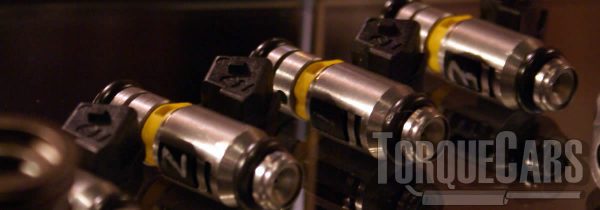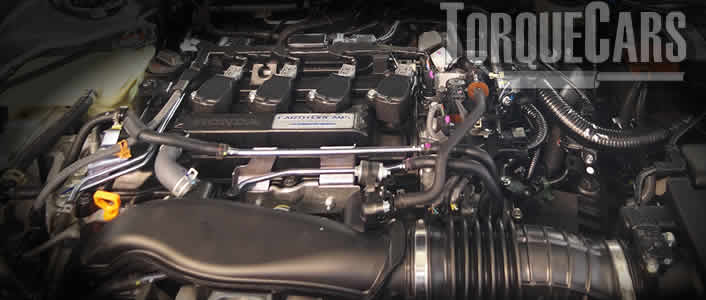Tuning the Honda L series
"Comprehensive guide to tuning the Honda L series engine!"
Our aim here is to look at L series tuning and outline the optimum modifications for your car. Honda L series have loads of potential and with the best tuning modifications like remapping, turbo upgrades and camshafts you will certainly maximise your driving experience.
The top L series tuning parts on an engine are typically the ones that give the best power gain for you spend.
We won't be swayed by popular L series tuning parts, they need to be cost effective.
The camshaft profile plays a big part in the engines power output so camshaft upgrades make quite a large difference. The intake and exhaust durations will alter depending on the chosen camshaft profile, so large engines power gains are on offer for camshaft upgrades.

NB: Fast road cams tend to bump the torque through the rev range, you could drop a little bottom end bhp but your high end rpm power will be lifted.
Motorsport cams, bump the high end rpm power band but as a result the car will not idle smoothly and low end power nearly always suffers.
A Competition cam is not great driving around busy urban areas.
You should ideally optimize your torque band to your typical driving style so for a car driven daily stick with a fast road L series cam

Some L series engines respond better to mild cam durations than others.
The ECU mapping and fuel pump and injectors also will make differences on the torque gains you'll get.
A longer valve duration can alter the torque band and on most engines the exhaust and intake durations do not need to match, although most cams and tuners use matched pairs there are some advantages to extending the intake or exhaust durations.
Stage 1 modifications: Remaps/piggy back ECU, Fast road camshaft, Sports exhaust manifold, Intake headers, Panel air filters, Drilled & smoothed airbox.
Stage 2 modifications: induction kit, Ported and polished head, high flow fuel injectors, Sports catalyst & performance exhaust, fuel pump upgrades, Fast road cam.
Stage 3 modifications: Crank and Piston upgrades to alter compression, Competition cam, Internal engine upgrades (head flowing porting/bigger valves), Adding or Upgrading forced induction (turbo/supercharger), Twin charging conversions, Engine balancing & blueprinting.
A remap allows a tuner to fully realize the full potential of all the upgrades you've fitted to your L series.
It will usually give around 30% more power on turbocharged vehicles and you can expect to see around 15% on NASP engines, but power output usually vary depending on the upgrades you've applied and the condition of your engine.
Shoving more air into the L series engine is the main goal to any engine tuning job.
The intake plenum transmit the air during the suck phase from the filter and allow it to be sucked into the engine cylinders with fuel for the squish phase.
Design and flow characteristics of the Intake headers can make a large improvement to fuel mixing and power on the L series.
Many mass produced engine intake manifold are ripe for an upgrade, although some manufacturers provide reasonably well designed intake manifold.
Larger L series valves, doing some 3 or 5 angle valve jobs and porting and head flowing will also increase power, and more importantly will afford you an improved power increase on other upgrades.
Turbo upgrades

NASP engines need quite a lot of work when you add a turbo, so we have a separate guide to help you take into account the pros and cons of going this route on your L series
The more air you can get into an engine, the more fuel it can burn and uprating the induction with a turbocharger upgrade makes significant power gains.
When your motor has a turbo already fitted upgrades are going to make more power and we find turbo engines are made with harder and stronger components.
There are tuning limits for every engine, with some being incredibly solid and some only just able to handle stock power
We recommend you find these restrictions and fit more solid crank and pistons to utilize the power.
There are many people spending a loads of money on turbo charger upgrades on the L series only to watch the engine block catastrophically fail just after it's been completed.
Larger turbos will usually experience low end lag, and low capacity turbos spool up more quickly but do not have the top end engines power gains.
In recent times the world of turbo chargers is always moving on and we now see variable vane turbo chargers, permitting the vane profile is altered according to speed to lower lag and increase top end power.
Twin scroll turbo chargers divert the exhaust flow into two channels and flow these at differently profiled vanes in the turbo. They also improve the scavenging effect of the engine.
It is not unusual that there's a limitation in the air flow sensor MAP/MAF/AFM on the L series when considerably more air is being fed into the engine.
We see 4 bar air sensors coping with quite large power gains, whereas the OEM air sensor limited bhp and torque at a much lower level.
Adding a supercharger or additional turbo will make large power gains, although more complex to configure. We have this article covering twinchargers if you want to read more.
Fuelling upgrades and mods
When you boost the performance you will need to ramp up to the fuel system.
More performance needs more fuel.  We would recommend you to over specify your flow rate on the injectors.
We would recommend you to over specify your flow rate on the injectors.
The rule of thumb is to add 20% to the flow rate when fitting an injector, this allows for injector deterioration and provides you some spare capacity should the engine need more fuel.
We think this one is common sense, but you'll need to match your fuel injector to the type of fuel your car uses as well.
Exhaust upgrades and mods
Only look to increase your exhaust if your current exhaust is creating a restriction.
On most factory exhausts you'll find the exhaust flow rate is good even on modest power gains, but when you start pushing up the power levels you will need to get a better flowing exhaust.
Sports exhausts generally help improve air flow through the engine but avoid an exhaust that is too large or you could will reduce the flow rate. Stick to 1.5 to 2.5 inches for best results.
Typically exhaust restrictions can be traced to the catalyst and filters installed, so adding a freer flowing performance alternative will help avoid this restriction.
Weak spots, Issues & common problem areas on the L series
The engines, if regularly serviced and maintained, are generally very reliable and have few issues.
Regular oil changes are vital on the , particularly when the engine has been modified and is putting down more power than the manufacturer intended.
History of the Engine

- 2001 1.3 L L13A (Fit/Jazz)
- 2001 1.4 L13A (Fit/Jazz)
- 2002 1.2 L L12A (Jazz)
- 2002 1.5 L L15A (Fit/Fit Aria/Airwave/Mobilio)
- 2013 1.5 L L15B DOHC (Fit)
- 2016 1.5 L L15B DOHC VTC Turbo (Honda Civic/Honda Accord/Honda HR-V/Honda CR-V)
- 2012 1.5 L LEA-MF6 (Honda Civic Hybrid)
For more information on Tuning your engine please join us in our friendly forum where you can discuss tuning options in more detail with our owners. It would also be worth reading our unbiased tuning articles to get a full grasp of the benefits and drawbacks of each modification.
We need your help improving this article, so please send us your feedback in the comments box below and pass on any tips, points or facts we have wrong or have not covered.
We really like hearing from our readers, and hearing about which upgrades were the most effective for them, it helps us improve our recommendations and articles to reflect current trends in modifications and ensures that our guides and tips are kept up to date.
Please Check out my YouTube channel, we're regularly adding new content...
PLEASE HELP: I NEED YOUR DONATIONS TO COVER THE COSTS OF RUNNING THIS SITE AND KEEP IT RUNNING. I do not charge you to access this website and it saves most TorqueCars readers $100's each year - but we are NON PROFIT and not even covering our costs. To keep us running PLEASE Donate here
If you liked this page please share it with your friends, drop a link to it in your favourite forum or use the bookmarking options to save it to your social media profile.
Feedback - What do You Think?
Please use our forums if you wish to ask a tuning question, and please note we do not sell parts or services, we are just an online magazine.
Help us improve, leave a suggestion or tip
Please watch this video and subscribe to my YouTube channel.

 Click to accept YouTube Cookies & Play.
Click to accept YouTube Cookies & Play.